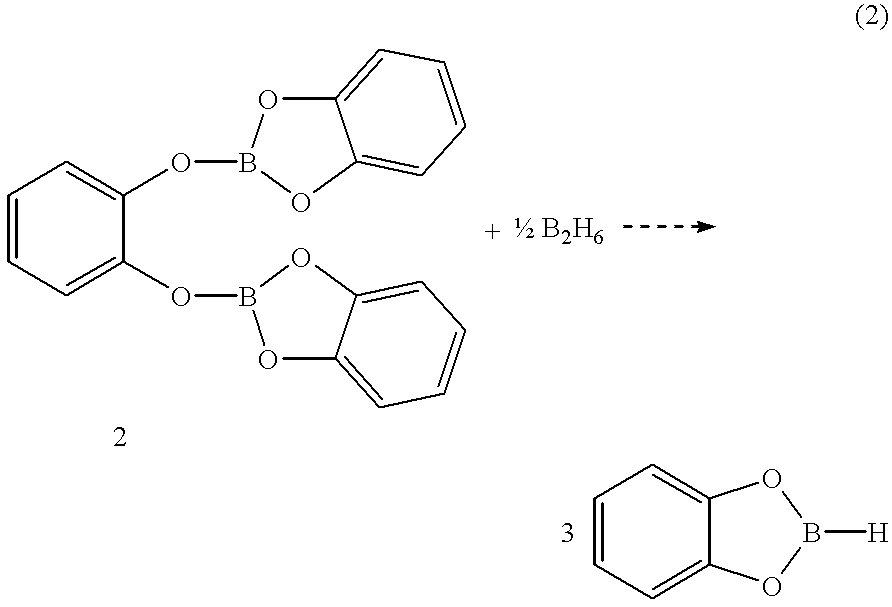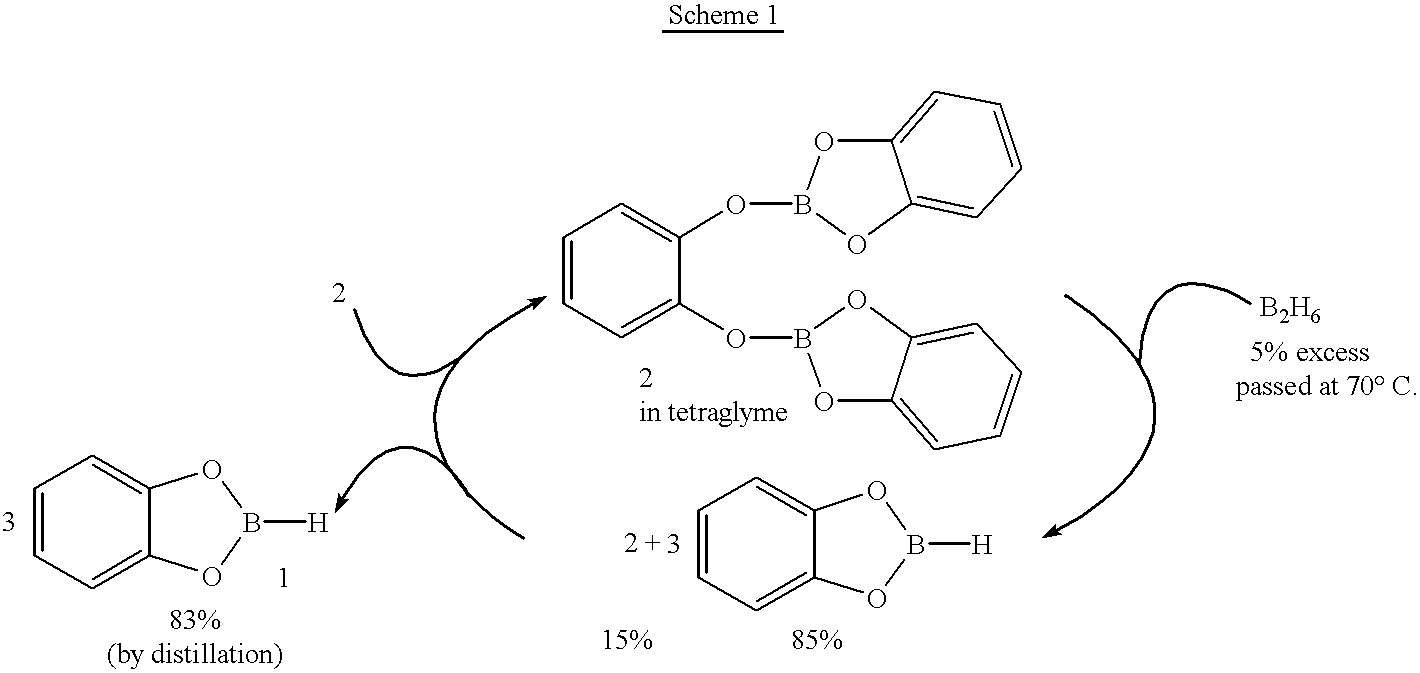Economical and convenient procedures for the synthesis of catecholborane
- Summary
- Abstract
- Description
- Claims
- Application Information
AI Technical Summary
Benefits of technology
Problems solved by technology
Method used
Image
Examples
example 2
Preparation of catecholborane from the borate 2 and diborane gas in toluene
The procedure followed for all solvents, such as toluene, n-heptane, tetralin, diphenyl ether, etc., was essentially the same and the procedure followed using tetraglyme as solvent is representative.
An oven-dried RB flask provided with a septum inlet, stirring bar and gas bubbler was assembled hot and cooled to room temperature under a stream of nitrogen. The gas bubbler was connected to a diborane generation set-up as described elsewhere. The flask was charged with the borate 2 (17.31 g, 50 mmol) in dry toluene (30 ml,) and the reaction mixture was kept at 90.degree. C. (bath temperature). Diborane gas (40 mmol, excess), generated as described elsewhere, (Brown, H. C. Organic Synthes via Boranes; Aldrich Chemical Co., Inc.; Milwaukee, Wis., 1997; Vol. 1, Kanth, J. V. B.; Brown, H. C. manuscript in preparation) was passed into the reaction mixture slowly, during 4 h. The diborane gas was slowly absorbed into ...
example 3
Preparation of catecholborane from the borate 2 and diborane gas in a glyme
The procedure followed in the glymes such as di-, tri-, and tetraglyme, was essentially the same and the procedure followed using tetraglyme as solvent is representative.
An oven-dried RB flask provided with a septum inlet, stirring bar and gas bubbler was assembled hot and cooled to room temperature under a stream of nitrogen. The gas bubbler was connected to a diborane generation set-up as described elsewhere. The flask was charged with the borate 2 (17.31 g, 50 mmol) in dry tetraglyme (30 mL) and the reaction mixture was kept at 70.degree. C. Diborane gas (30 mmol, small excess), generated as described elsewhere. (Brown, H. C. Organic Synthesis via Boranes; Aldrich Chemical Co., Inc.; Milwaukee, Wis., 1997; Vol. 1, Kanth, J. V. B.; Brown, H. C. manuscript in preparation) was passed into the reaction mixture slowly. The diborane gas was readily absorbed into the borate-tetraglyme mixture. The .sup.11 B NMR e...
example 4
Preparation of catecholborane from the borate 2 and borane-Lewis base complex without solvent
The procedure followed with all the borane-Lewis base complexes, wherein the Lewis base could an amine, cyclic ether or dialkyl sulfide, is essentially same. The following procedures are representative.
An oven-dried RB flask provided with a septum inlet, stirring bar and a reflux condenser was assembled hot and cooled to room temperature under a stream of nitrogen. The flask was charged with the borate 2 (17.31 g, 50 mmol) and borane-methyl sulfide (5.0 mL, 10.2 M, 51 mmol). The reaction mixture was slowly heated to 100.degree. C. for 1 h, by which time the .sup.11 B NMR examination showed the disappearance of the peak due to borane-methyl sulfide complex (-20.2 ppm, q) and the appearance of a new peak due to catecholborane (+28.3 ppm, d). The methyl sulfide liberated, was pumped-off and the residue was distilled under reduced pressure to obtain catecholborane in 85% yield (13.64 g) and 97% ...
PUM
 Login to View More
Login to View More Abstract
Description
Claims
Application Information
 Login to View More
Login to View More - R&D
- Intellectual Property
- Life Sciences
- Materials
- Tech Scout
- Unparalleled Data Quality
- Higher Quality Content
- 60% Fewer Hallucinations
Browse by: Latest US Patents, China's latest patents, Technical Efficacy Thesaurus, Application Domain, Technology Topic, Popular Technical Reports.
© 2025 PatSnap. All rights reserved.Legal|Privacy policy|Modern Slavery Act Transparency Statement|Sitemap|About US| Contact US: help@patsnap.com



